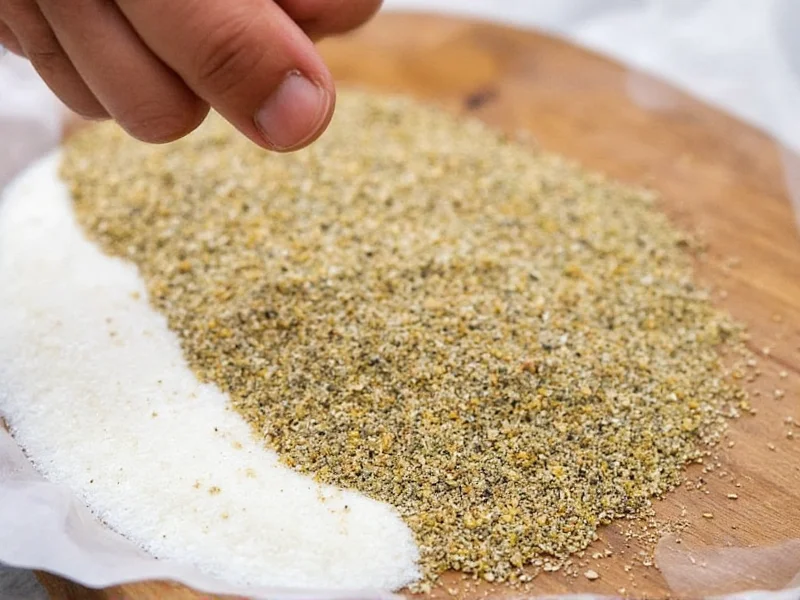Ranch seasoning has become a pantry staple across American kitchens, but many consumers don't realize what actually comprises this popular flavor profile. Understanding the precise ingredients helps home cooks use it effectively and even create homemade versions tailored to their preferences.
Core Ingredients in Commercial Ranch Seasoning
While specific formulations vary by brand, all authentic ranch seasoning mixes share these essential components that create the distinctive tangy, herbaceous flavor:
| Ingredient | Primary Function | Typical Percentage |
|---|---|---|
| Buttermilk powder | Provides signature tanginess | 25-35% |
| Garlic powder | Delivers savory depth | 15-20% |
| Onion powder | Creates aromatic base | 15-20% |
| Dill weed | Contributes fresh herbal notes | 8-12% |
| Parsley | Adds brightness and color | 5-8% |
| Chives or chive powder | Provides onion-like freshness | 3-5% |
| Salt | Enhances flavor and acts as preservative | 10-15% |
| Black pepper | Offers subtle heat and complexity | 2-4% |
How Ranch Seasoning Differs From Ranch Dressing
Many people confuse ranch seasoning with ranch dressing, but they're fundamentally different products. Ranch seasoning is a dry powder mix containing dehydrated ingredients, while ranch dressing includes liquid components like buttermilk, sour cream, and mayonnaise.
The critical distinction lies in buttermilk powder versus liquid buttermilk. Buttermilk powder in seasoning mixes provides the characteristic tang without moisture, making it shelf-stable for months. When you add liquid to ranch seasoning mix, it reconstitutes into dressing. This explains why what's in ranch seasoning packets lacks the creamy texture of bottled dressing.
Variations Across Commercial Brands
Examining different store brands reveals how what ingredients are in ranch seasoning mix can vary significantly:
- Hidden Valley Original: Contains maltodextrin and calcium stearate as anti-caking agents
- McCormick Ranch: Includes citric acid for enhanced tanginess
- Great Value (Walmart): Uses modified food starch as a thickener
- Organic brands: Substitute buttermilk powder with coconut milk powder for dairy-free versions
These variations affect both flavor profile and dietary considerations, particularly for those monitoring sodium intake or avoiding specific additives.
Creating Authentic Homemade Ranch Seasoning
Knowing what gives ranch seasoning its distinctive flavor allows you to craft superior homemade versions. The essential ratio for a basic mix is:
- ¼ cup buttermilk powder (the non-negotiable base)
- 2 tablespoons garlic powder
- 2 tablespoons onion powder
- 1½ tablespoons dried dill
- 1 tablespoon dried parsley
- 1 teaspoon dried chives
- 1½ teaspoons salt
- ½ teaspoon black pepper
Mix these thoroughly and store in an airtight container. For homemade ranch seasoning recipe ingredients with enhanced flavor, consider adding a pinch of paprika for subtle sweetness or a dash of lemon zest powder for brightness.
Nutritional Profile and Dietary Considerations
Two tablespoons of typical ranch seasoning mix contains approximately:
- Calories: 25-30
- Total fat: 0.5g
- Sodium: 450-600mg (19-25% of daily value)
- Carbohydrates: 5g
- Protein: 1g
The high sodium content is the primary health consideration when using ranch seasoning. Many commercial blends contain 20-25% of your daily sodium in just two tablespoons. For those monitoring sodium intake, look for low-sodium versions or create your own mix with reduced salt.
Practical Applications Beyond Salad Dressing
Understanding what's in ranch seasoning mix reveals its versatility extends far beyond salads. The dry format makes it ideal for:
- As a dry rub for chicken, fish, or vegetables before roasting
- Mixed with olive oil for a quick marinade
- Added to mashed potatoes for extra flavor
- Stirred into sour cream for instant vegetable dip
- Combined with breadcrumbs for flavorful coatings
- Whisked into vinaigrettes for creamy texture without dairy
The buttermilk powder in ranch seasoning particularly excels at tenderizing proteins while adding flavor, making it valuable for dry brining applications where liquid marinades would be impractical.
History of Ranch Seasoning Development
Ranch seasoning's origins trace back to the 1950s when Steve Henson created ranch dressing at his Santa Barbara guest ranch. The dry seasoning version emerged later as food manufacturers sought shelf-stable alternatives to the perishable dressing.
Food scientists faced the challenge of preserving the complex flavor profile without liquid ingredients. The breakthrough came with buttermilk powder technology in the 1970s, allowing manufacturers to capture ranch's signature tang in dry form. This innovation transformed ranch from a regional dressing into America's most popular seasoning blend.
Frequently Asked Questions
What's the difference between ranch dressing mix and ranch seasoning?
Ranch dressing mix typically contains additional thickeners and emulsifiers designed to create a creamy dressing when combined with mayonnaise and buttermilk. Ranch seasoning is a simpler blend intended for direct use as a dry spice rub or flavor enhancer without requiring additional preparation steps.
Can I substitute ranch seasoning for dried herbs in recipes?
Yes, but with caution. Ranch seasoning contains salt and buttermilk powder in addition to herbs, so you'll need to adjust other ingredients accordingly. For every tablespoon of ranch seasoning used as a herb substitute, reduce added salt by ¼ teaspoon and consider the dairy component in your recipe.
Why does ranch seasoning contain buttermilk powder?
Buttermilk powder provides the characteristic tangy flavor that defines ranch without adding moisture. It's dehydrated cultured milk that maintains stability in dry spice blends while delivering the distinctive sour note that distinguishes ranch from other herb seasonings.
Is ranch seasoning gluten-free?
Most basic ranch seasoning blends are naturally gluten-free as they contain only herbs, spices, and dairy powder. However, some commercial brands add maltodextrin or modified food starch which may be derived from wheat. Always check labels if you require strictly gluten-free products.
How long does ranch seasoning stay fresh?
Properly stored in an airtight container away from heat and moisture, ranch seasoning maintains optimal flavor for 6-12 months. The buttermilk powder may begin losing potency after this period, though the mix remains safe to consume. For longest shelf life, store in the refrigerator or freezer.











 浙公网安备
33010002000092号
浙公网安备
33010002000092号 浙B2-20120091-4
浙B2-20120091-4